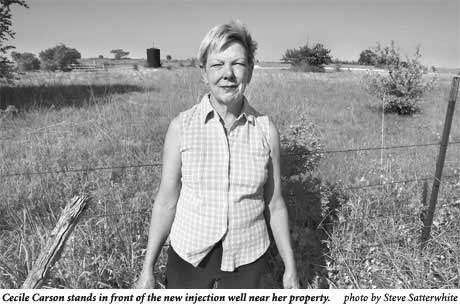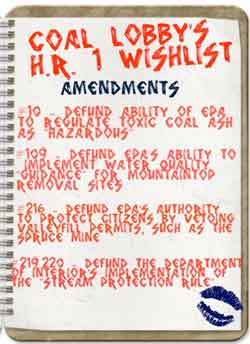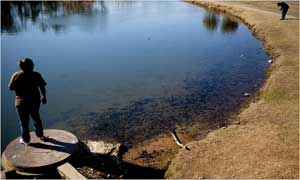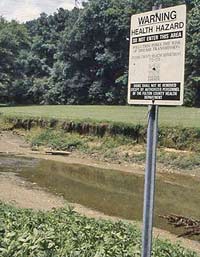Biblio
Cecile Carson's property has an aura of rural homeyness. The neat yard, happy dogs, and blooming flowers along her fence rails suggest a love of place.
She's a high school art teacher who picked a little swath of Wise County near the small town of Decatur, about 35 miles north of Fort Worth, to settle down. She lived in a travel trailer for the first three years while she designed and built her home. The place is well thought out—its colors blend with the surrounding landscape of green, rolling hills.
It took Carson 10 years to get to this point. But it took the Railroad Commission of Texas about 45 seconds to put it all in jeopardy. On April 11, at an administrative hearing in Austin, it took less than a minute for a public reading of Carson's and her neighbor's protests against the placement of an oilfield waste injection well just a few hundred feet from their property.
Then the three commissioners immediately voted "denied" without discussion...
...Part of the commission's enforcement problem is a lack of effective penalties. After the commission field staff goes through an elaborate protocol of voluntary compliance with an offending operator, the inspector must dot every "i" and cross every "t" in order to file a legal enforcement package that will, at most, result in a fine of between $500 and $3,500.
New York Department of Environmental Conservation (NYDEC). Information from DEC with links to other legal issues.
See: Landman Report Card
The National Children’s Study will examine the effects of the environment, as broadly defined to include factors such as air, water, diet, sound, family dynamics, community and cultural influences, and genetics on the growth, development, and health of children across the United States, following them from before birth until age 21 years.
The goal of the Study is to improve the health and well-being of children and contribute to understanding the role various factors have on health and disease. Findings from the Study will be made available as the research progresses, making potential benefits known to the public as soon as possible.
Ultimately, the National Children’s Study will be one of the richest research efforts geared towards studying children’s health and development and will form the basis of child health guidance, interventions, and policy for generations to come. For more details on the Study, see the Study Overview.
Watch this video and learn more about the Study.
See: Fracking: Implications for Human and Environmental Health
See: Living Downstream: An Ecologist's Personal Investigation of Cancer and the Environment
See: Poisoned profits : the toxic assault on our children
See: The Case for a Truth and Reconciliation Commission on Toxic Hazards
One of the most glaring omissions during Obama’s State of the Union address was the acknowledgement of climate change. As the Senate and House return to Capitol Hill both sides are gearing up to attack the existing tool in place to address greenhouse gases – the Clean Air Act...
...Instead of addressing these threats to the Clean Air Act, Obama shifted the focus to the need for “clean energy” – stating the goal of an 80% clean energy sector by 2035 – a seemingly positive objective if the energy sources he referred to were actually clean. But in this case, dirty energy by any other name is still dirty energy. Obama’s clean energy plan includes dirty technologies such as nuclear reactors, coal, natural gas and biomass. Learn more here.
About Us
Corporations have their lobbyists in Washington, D.C.
The people need advocates too.
We have successfully challenged the abusive practices of the pharmaceutical, nuclear and automobile industries, and so many others. We are leading the charge against undemocratic trade agreements that advance the interests of mega-corporations at the expense of citizens worldwide.
We have five policy groups: our Congress Watch division, the Energy Program, Global Trade Watch, the Health Research Group and our Litigation Group. Learn more about them here.
WASHINGTON COUNTY, PA - At first, farmer Ron Gulla and horse farm owner Joyce Mitchell were excited about the prospect of making money from gas drilling. Now, after more than two years of the presence of drilling companies with their heavy trucks and huge drill rigs, they and many of their neighbors wish they had never signed a lease.
Gasses bubbling out of the ground and into drinking wells and ponds. Before drilling is begun, a landowner should have the water tested for baseline items, he said. “The only problem is that such tests can be very costly.”
WORC is a regional network of seven grassroots community organizations that include 10,000 members and 45 local chapters. WORC helps its member groups succeed by providing training and coordinating issue work.
Our Member Organizations are:
- Dakota Rural Action
- Dakota Resource Council
- Idaho Rural Council
- Northern Plains Resource Council
- Oregon Rural Action
- Powder River Basin Resource Council
- Western Colorado Congress
WORC’s mission is to advance the vision of a democratic, sustainable, and just society through community action. WORC is committed to building sustainable environmental and economic communities that balance economic growth with the health of people and stewardship of their land, water, and air resources.
See: Group: Survey shows ill health in Wyoming 'fracking' zone
Powder River Basin Resource Council and EARTHWORKS release a survey showing residents report respiratory problems from gas drilling. (Casper Star-Tribune, August 19, 2010)
Dave McMahon is a lawyer who wrote the West Virginia Surface Owner’s Guide to Oil and Gas.
According to this website, he will respond to an e-mail, or spend 5 minutes or so with anyone who calls on the phone with a question about their individual problem, and perhaps refer them on to a private lawyer for representation. See an example Gas Lease Checklist here.
Includes high-resolution image of a frack site. Permission to use may be obtained from WVSORO.
It's really hard for me to read about the Dunkard Creek fish kill without getting very angry.
An ecosystem has been destroyed.
...the 38-mile creek is all but dead, its 161 species of fish, mussels, salamanders, crayfish and aquatic insects killed by mysterious pollutants coming from sources state and federal agencies have yet to pinpoint despite aggressive field work.
The investigation thus far indicates the most likely cause as oil and gas drilling wastewater. (There's more ability to generate wastewater from the Marcellus Shale drilling than there are wastewater treatment facilities in the area, so the incentive for rogue wastewater disposal is high.)
West Virginia Community Blog. The Best Blogging Community in West Virginia. Democratic politics, progressive policies, the good life and free living in Wild, Wonderful West Virginia.
Jane Park.
Interview with blogger Elizabeth Berkowitz.
Cindy Kalbach and her husband have lived in Gaines for 10 years, enjoying the quiet wilderness. But that's become a lot harder because of increasing drilling activity. With wells as close as a mile away, trucks from gas companies are ravaging their roads, kicking up dust, driving away wildlife and keeping the Kalbachs indoors. Kalbach refuses to lease her land to gas companies, but some of her neighbors haven't been able to resist the offers. People around here are very low income. They just want to live here in peace, you know? And that's a lot of money to them. they don't realize what they're getting into,said Kalbach. Kalbach took her concerns to Elizabeth Berkowitz, an avid blogger who started Faces of Frackland to give a voice to people who feel like no one is listening.
Kentucky ranks dead last in healthy behavior, and 49th in overall well-being, emotional health, and physical health (behind WV of course). More mountaintop removal will only make these problems with the health of Appalachian people even worse. Its hard to get worse than worst, but Hal Rogers is doing his darndest.
Yesterday the coal lobby added a litany of dangerous amendments to HR 1 that had nothing to do with spending, but instead are aimed at removing citizen protections from mountaintop removal.
Why Americans Should Oppose Rep Hal Rogers’ Federal Budget (HR 1)
Appalachia saw several new threats arise in Congress yesterday, as Representatives of Congress introduced bad amendment after bad amendment after bad amendment to the already dangerous Budget Resolution (H.R. 1) that is due to be voted on as soon as tonight. In all, more than 400 amendments were filed yesterday and an additional 180 have been filed today. Many of them reflected Congressman Hal Rogers’ own sentiments about how to govern – disregarding citizen protections and sound science, while encouraging the complete and utter deregulation of large polluting industries that are a threat to public health and well-being. We’ve seen what happens when Mr. Rogers’ policies are put into place, as they have been in eastern Kentucky for decades.
Of the 435 Congressional districts, Rogers’ district (KY-05) is #1 in mountaintop removal and stream damages by the coal industry. But it is also DEAD LAST in well being.
Hal Rogers’ neighborhood may be “dead first” in mountaintop removal, but out of the 435 congressional districts in the United States, his ranks:
- 435th in life expectancy (dead last)
- 435th in physical health (dead last)
- 435th in overall well-being (dead last)
- 435th in emotional health (dead last)
See: iLoveMountains
See: GOP Budget Amendments Would Destroy Health, Economy, Planet.
Thousands of the nation’s largest water polluters are outside the Clean Water Act’s reach because the Supreme Court has left uncertain which waterways are protected by that law, according to interviews with regulators.
As a result, some businesses are declaring that the law no longer applies to them. And pollution rates are rising.
Companies that have spilled oil, carcinogens and dangerous bacteria into lakes, rivers and other waters are not being prosecuted, according to Environmental Protection Agency regulators working on those cases, who estimate that more than 1,500 major pollution investigations have been discontinued or shelved in the last four years.
The Clean Water Act was intended to end dangerous water pollution by regulating every major polluter. But today, regulators may be unable to prosecute as many as half of the nation’s largest known polluters because officials lack jurisdiction or because proving jurisdiction would be overwhelmingly difficult or time consuming, according to midlevel officials.
“We are, in essence, shutting down our Clean Water programs in some states,” said Douglas F. Mundrick, an E.P.A. lawyer in Atlanta. “This is a huge step backward. When companies figure out the cops can’t operate, they start remembering how much cheaper it is to just dump stuff in a nearby creek.”

See: PBS Frontline: "Poisoned Waters"
See Video report: "Supreme Court Restricts Clean Water Act". | Mixplex
See: Kid's view of a local water-quality problem
Students in the Atlanta and Columbus, Ga. area formed The River Kids Network, which tests and cleans up local streams (wearing gloves and boots, of course). Is there an organization in your area that does similar work?
Here are some 3rd graders' observations during a recent creek cleanup:
Not safe, even for bugs
"It's not looking so good. Raw sewage is in the Chattahoochee River, and not many critters can survive there. If bugs can't survive in there, what are humans going to do?"
Just a little effort
"I would just like the river to be clean enough so I could splash around and maybe drink some water. It wouldn't be very hard to make a difference."
Had it up to here
"The problem is that there are sewage leaks going to the creek and the creek goes into the big river. Everyone should help. If everyone helped, you could see right down to the bottom of the creek."
Out from under cover
"I want to play in the creek and not have to wear gloves and boots."
Signs of life are few
"On our monthly trips, we've found a lot of trash, including more than 18 tires, a radio, shoes and plastic bags. We've only found a few forms of life. We saw one turtle and a few bugs, but not many fish."
A federal judge has overturned water quality rules that were meant to protect southeastern Montana cropland from natural gas drilling but were assailed by Wyoming as a threat to energy production.
The rules covered the Tongue and Powder rivers, which flow north from the rich gas fields of northeastern Wyoming into primarily agricultural land in Montana.
Drafted by Montana and approved by the Environmental Protection Agency, the rules limited how much salty water - a byproduct of drilling - could enter the rivers. State officials said the EPA had not yet begun to enforce the rules, in part because of a pending lawsuit.
In a judgment in that case issued Tuesday, U.S. District Judge Clarence Brimmer in Cheyenne, Wyo., annulled the rules and sent them back to the EPA to reconsider. Brimmer wrote that the EPA had failed to give the water quality standards a full review when it approved them in 2003 and 2008.
The lawsuit has pitted natural gas companies backed by the state of Wyoming against the EPA and Montana.
The case represents one of several running skirmishes between Montana and Wyoming over the rivers that flow north across their shared border.
Jim Robbins. September 10, 2006. New York Times.
It is a strange fight, Montana ranchers say. Raising cattle here in the parched American outback of eastern Montana and Wyoming has always been a battle to find enough water.
Now there is more than enough water, but the wrong kind, they say, and they are fighting to keep it out of the river.
Mark Fix is a family rancher whose cattle operation depends on water from the Tongue River. Mr. Fix diverts about 2,000 gallons per minute of clear water in the summer to transform a dry river bottom into several emerald green fields of alfalfa, an oasis on dry rangeland. Three crops of hay each year enable him to cut it, bale it and feed it to his cattle during the long winter.
“Water means a guaranteed hay crop,” Mr. Fix said.
But the search for a type of natural gas called coal bed methane has come to this part of the world in a big way. The gas is found in subterranean coal, and companies are pumping water out of the coal and stripping the gas mixed with it. Once the gas is out, the huge volumes of water become waste in a region that gets less than 12 inches of rain a year.
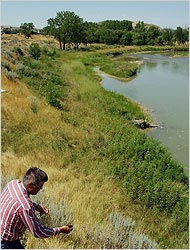
Mark Fix, a cattle rancher in eastern Montana, diverts about 2,000 gallons per minute of Tongue River water in the summer to grow hay for his livestock. But increased sodium in the water could endanger his hayfields.
See: Molly Ivins. (2004) C-Span Book TV Oct. 2, 2004. Bushwacked: Life in George W. Bush's America. Chapter: "Dick, Dubya, and Wyoming Methane." (152)
The estimated population of Pulteney is about 1,300.
At times Sunday it looked like every one of them was crowded into the Pulteney Fire Hall to discuss the proposed plan to deposit contaminated wastewater in a former natural gas well.
More than 300 people came to hear a panel discuss the plan. Chesapeake Energy approached Pulteney officials last fall about the plan to dump the wastewater, which is generated from the hydrofracking process, into a well about a mile west of Keuka Lake.







